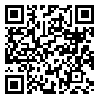Volume 6, Issue 1 (1-2018)
JoMMID 2018, 6(1): 31-34 |
Back to browse issues page
Download citation:
BibTeX | RIS | EndNote | Medlars | ProCite | Reference Manager | RefWorks
Send citation to:



BibTeX | RIS | EndNote | Medlars | ProCite | Reference Manager | RefWorks
Send citation to:
Momeni S, Najafi F, Naddaf S R, Zahabiun F, Hosseini M, Mohammadi Z, et al . Infection of Afghan Pika (Ochotona rufescens) with Oxyurid Worms in Northeastern Iran . JoMMID 2018; 6 (1) :31-34
URL: http://jommid.pasteur.ac.ir/article-1-170-en.html
URL: http://jommid.pasteur.ac.ir/article-1-170-en.html
Somaye Momeni 

 , Faezeh Najafi
, Faezeh Najafi 

 , Saied Reza Naddaf
, Saied Reza Naddaf 

 , Farzaneh Zahabiun
, Farzaneh Zahabiun 

 , Mostafa Hosseini
, Mostafa Hosseini 

 , Zeinolabedin Mohammadi
, Zeinolabedin Mohammadi 

 , Mansour Aliabadian
, Mansour Aliabadian 

 , Gholamreza Mowlavi *
, Gholamreza Mowlavi * 




 , Faezeh Najafi
, Faezeh Najafi 

 , Saied Reza Naddaf
, Saied Reza Naddaf 

 , Farzaneh Zahabiun
, Farzaneh Zahabiun 

 , Mostafa Hosseini
, Mostafa Hosseini 

 , Zeinolabedin Mohammadi
, Zeinolabedin Mohammadi 

 , Mansour Aliabadian
, Mansour Aliabadian 

 , Gholamreza Mowlavi *
, Gholamreza Mowlavi * 


Department of Parasitology and Mycology, School of Public Health, Tehran University of Medical Sciences, Tehran, Iran
Abstract: (7643 Views)
Introduction: The Afghan pika (Ochotona rufescens) is a small mammal in the family Ochotonidae. This small mammal occurs in Afghanistan, Iran, Pakistan, and Turkmenistan. Here, we investigated the helminth infections among the Afghan pikas from northeastern Iran. Methods: Fourteen Afghan pikas were entrapped from Bojnord, Mashhad, Birjand, and Tandoureh in the northeast of Iran during 2013-2015. The animals were euthanized, dissected, and their gastrointestinal tracts were removed, which were then cut longitudinally, and inspected under a stereomicroscope for the presence of helminths. Also, using the formalin-ether concentration technique, the intestinal contents of the animals were examined microscopically for helminths eggs. Results: Out of 14 pikas examined, 11 (78%) harbored at least one helminth species and mixed infections with two helminths were observed in 3 (21%) animals. Four oxyurid species including Cephaluris chabaudi, Cephaluris akhtar, Fastigiuris prudhoei, and Dermatoxy schneider were identified. Also, the Oxyurid eggs were recovered from the intestinal contents of four pikas. No significant difference (P>0.05) was observed in infection rate between male and female animals and between the areas. Conclusion: Oxyurid worms were the only prevalent infection among the Afghan pikas in northeastern Iran. The absence of other helminthic infections in pikas of the study area might be attributed to various factors like the lack of hosts species, high-elevation, and adequate moisture which facilitate the life cycle of many helminths species.
Type of Study: Original article |
Subject:
Other
Received: 2018/07/16 | Accepted: 2018/07/23 | Published: 2018/08/27
Received: 2018/07/16 | Accepted: 2018/07/23 | Published: 2018/08/27
References
1. -------------
1. Chapman JA, Flux JE. Introduction to the Lagomorpha. Lagomorph Biology: Evolution, Ecology and Conservation. Springer. 2008; 1-9. [PMCID]
2. 2. Sahneha SK, Nourib Z, Shabanic AA, Ahmadid M, Dargahie MD. Bioclimatic niche model to predict Afghan Pika (Ochotona rufescens) distribution range in Iran. Biological Forum. An International Journal. 2014; 96 (2): 96-102.
3. 3. Wang C, He H, Li M, Lei F, Root JJ, Wu Y, Qin J. Parasite species associated with wild plateau pika (Ochotona curzoniae) in southeastern Qinghai Province, China. J Wildl Dis. 2009; 45 (2): 288-94. [DOI:10.7589/0090-3558-45.2.288] [PMID]
4. 4. Okamoto M, Kamiya M, Oku Y, Ohbayashi M, Matsuzaki T. Susceptibility of laboratory-reared Afghan pika, Ochotona rufescens rufescens (Lagomorpha: Ochotonidae), to gastrointestinal nematodes of ruminants. Nihon juigaku zasshi. 1988; 50 (4): 913-7. [DOI:10.1292/jvms1939.50.913] [PMID]
5. 5. Smith AT, Johnston CH, Alves PC, Hackländer K. Lagomorphs: Pikas, Rabbits, and Hares of the World: Johns Hopkins University Press; 2017; 77-8.
6. 6. Rafique A, Rana S, Khan H, Sohail A. Prevalence of some helminths in rodents captured from different city structures including poultry farms and human population of Faisalabad, Pakistan. Pak Vet J. 2009; 29 (3): 141-4.
7. 7. HOBBS RP. A revision of the genus Cephaluris Akhtar, 1947 (Nematoda: Oxyuridae) with redescriptions of the North American species. Proc Helminthol Soc Wash. 1976; 43 (2): 151-60.
8. 8. Amin HA, Ali SA. Evaluation of different techniques of stool examination for intestinal parasitic infections in Sulaimani City-Iraq. Int J Curr Microbiol Appl Sci. 2015; 4 (5): 991-6.
9. 9. Najafi F, Rezaie S, Kia E, Mobedi I, Mahmodi M, Salimi M, Hasanpour H, Makki M, Mowlavi G. Intestinal Helminths in Laboratory Mice and Rats in Four Research Centers, Tehran, Iran. J Med Microbiol Infect Dis. 2014; 2 (4): 130-2.
10. 10. Najafi F, Naddaf SR, Rezaie S, Kia EB, Mowlavi G. In Vitro Ovicidal Activity of Nematophagous Fungus Paecilomyces lilacinus on the Eggs of Parasitic Helminths. J Med Microbiol Infect Dis. 2016; 4 (3): 52-6.
11. 11. Hugot J-P, Gardner SL, Borba V, Araujo P, Leles D, Da-Rosa ÁAS, Dutra J, Ferreira LF, Araújo A. Discovery of a 240 million year old nematode parasite egg in a cynodont coprolite sheds light on the early origin of pinworms in vertebrates. Parasit Vectors. 2014; 7 (1): 486. [DOI:10.1186/s13071-014-0486-6]
12. 12. Roberts LS, Janovy J, Schmidt GD. Foundations of parasitology. 6 th ed. McGraw-Hill; 1996; 130-1.
13. 13. Inglis WG. Some oxyurid parasites (Nematoda) from Ochotona rufescens vizier (Mammalia: Lagomorpha) in Iran. Bulletin de la Societe Zoologique de France. 1959; 84 (213): 178-87.
14. 14. Sadighian A, Ghadirian E, Sadjadpour E. Two new species of nematodes of lagomorphs and rodents from Iran. J Helmint. 1974; 48 (4): 241-5. [DOI:10.1017/S0022149X00022926]
15. 15. Hoberg EP, Pilitt PA, Galbreath K. Why museums matter: a tale of pinworms (Oxyuroidea: Heteroxynematidae) among pikas (Ochotona princeps and O. collaris) in the American West. J Parasitol. 2009; 95 (2): 490-501. [DOI:10.1645/GE-1823.1] [PMID]
16. 16. Jacobson HA, Kirkpatrick RL, McGinnes BS. Disease and physiologic characteristics of two cottontail populations in Virginia. Wildl Monog. 1978; (60): 3-53.
Send email to the article author
| Rights and permissions | |
 |
This work is licensed under a Creative Commons Attribution-NonCommercial 4.0 International License. |

This work is licensed under a Creative Commons Attribution-NonCommercial-NoDerivatives 4.0 International License.



